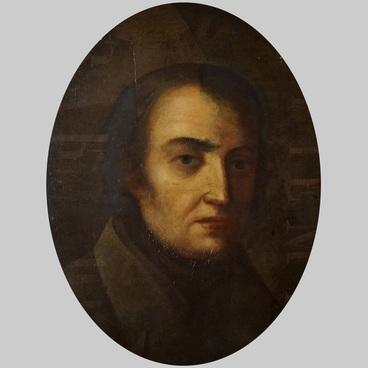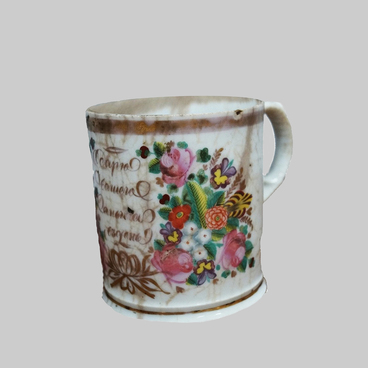The painting from the collection of History and Art Museum of Arzamas was created in the 19th century. The exact name of the artist was not identified. We only know that he was a student of artist Alexander Stupin. This was suggested by typical features of the style of Arzamas school of painting: austerity of drawing, use of dark background, focus on the character’s face, especially on the eyes; the genre of portrait painting itself was characteristic of Stupin school. The fact that it was impossible to determine the authorship of a painting in Stupin school usually means that the artist was a serf. Serfs did not possess many civil rights, including the right of authorship, so they could not sign their paintings.
The portrait depicts an unknown elderly man. The painting is done in a realistic manner. The man’s face is painted in thin, accurate strokes resembling a print: Stupin’s students often practiced copying prints and lithographs, they were more affordable than paintings. The background is painted with a wide brush.
Alexander Stupin was born in 1776 in Arzamas. He first studied icon painting but soon got interested in secular painting. When the artist turned 21, he opened his own studio. Alexander Stupin became the founder of the provincial school of painting – Stupin school in Arzamas opened in 1802 was one of the first art schools for peasant serfs.
The art school existed for 60 years. It was the first school for Vasily Perov, Evgraf Krendovsky, Ivan Zaitsev, Vasily Raev and other painters that later became well-known and participated in the establishment of the Association of Itinerant Art Exhibitions. Until 1836, Alexander Stupin managed the school himself and later passed the management to his former student Nikolai Alexeyev. Alexander Stupin was awarded with the Order of Saint Anna III class for establishing the school, and the Order of Saint Vladimir IV class for his contribution to the development of Russian painting.
The portrait depicts an unknown elderly man. The painting is done in a realistic manner. The man’s face is painted in thin, accurate strokes resembling a print: Stupin’s students often practiced copying prints and lithographs, they were more affordable than paintings. The background is painted with a wide brush.
Alexander Stupin was born in 1776 in Arzamas. He first studied icon painting but soon got interested in secular painting. When the artist turned 21, he opened his own studio. Alexander Stupin became the founder of the provincial school of painting – Stupin school in Arzamas opened in 1802 was one of the first art schools for peasant serfs.
The art school existed for 60 years. It was the first school for Vasily Perov, Evgraf Krendovsky, Ivan Zaitsev, Vasily Raev and other painters that later became well-known and participated in the establishment of the Association of Itinerant Art Exhibitions. Until 1836, Alexander Stupin managed the school himself and later passed the management to his former student Nikolai Alexeyev. Alexander Stupin was awarded with the Order of Saint Anna III class for establishing the school, and the Order of Saint Vladimir IV class for his contribution to the development of Russian painting.

